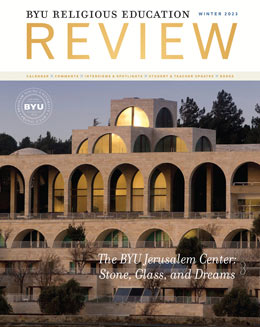Perspectives from Jerusalem and Beyond
Editor's Note
Jared Ludlow, Publications Director
Jared W. Ludlow (jared_ludlow@byu.edu) is the Publications Director of the BYU Religious Studies Center.
Jerusalem is one of the most well-known cities in the world, but its notoriety is not for the same reasons as other well-known cities (such as large population, economic power, status as a former imperial capital, or cutting-edge modern advances). Instead, it is Jerusalem’s history that continues to draw people to it and why people know its name even if they have never been near it. Specifically, Jerusalem’s religious history makes it significant particularly among the three great faith traditions of Judaism, Christianity, and Islam. Among these faiths, it is not only Jerusalem’s past that garners their attention, but its future as well. Jerusalem’s history and future are reasons for the competition over it among various peoples. It is a city too important to simply ignore and abandon.
Jerusalem is also home to a tremendous study abroad program for BYU students from the three BYU campuses. Closed for several semesters due to COVID restrictions, thankfully students are again able to travel to Jerusalem, the Holy Land, and neighboring countries. Our feature article focuses on the physical heart of this program: the BYU Jerusalem Center. Its miraculous origin, beautiful architecture, and lovely grounds provide a welcome home base for all that the program does within a semester. Jim Kearl, who has overseen the Center since its construction, shares a little of its history, its renovations—including most recently during the COVID hiatus—and new opportunities for alumni of the program. The BYU Jerusalem Center continues to contribute not only as a landmark with beautiful panoramic views of Jerusalem but also as a hub for interaction among local communities and visitors in an effort to bring about greater understanding and friendship.
Besides the feature article, this issue highlights the important work some Religious Education faculty are doing with the Family Foundations of Youth project, researching and discussing the challenges youth are facing and how religious activity can help with some of those challenges. We also review the history of the BYU Easter Conference, which has blossomed into a meaningful event that helps many Latter-day Saints prepare for the Easter season by remembering the atonement and resurrection of our Savior Jesus Christ. Related to the Easter season, we additionally highlight one of our upcoming books, Greater Love Hath No Man: A Latter-day Saint Guide to Celebrating the Easter Season, which provides scriptural background and ideas for families to commemorate events associated with Holy Week.
Finally, we have a piece that reviews the important thoughts that Barbara Morgan Gardner has shared on empowering women in the gospel and scriptures to reach greater knowledge and spiritual strength. As we proceed into this new year, we are grateful for the hard work and contributions of so many religious scholars that have given us such material to explore. We also express gratitude for the efforts of faculty, staff, and administrators at the BYU Jerusalem Center that have created life-changing opportunities for study-abroad students. These efforts from so many people can help all of us draw closer to Christ.
Jared W. Ludlow
Publications Director
BYU Religious Studies Center
